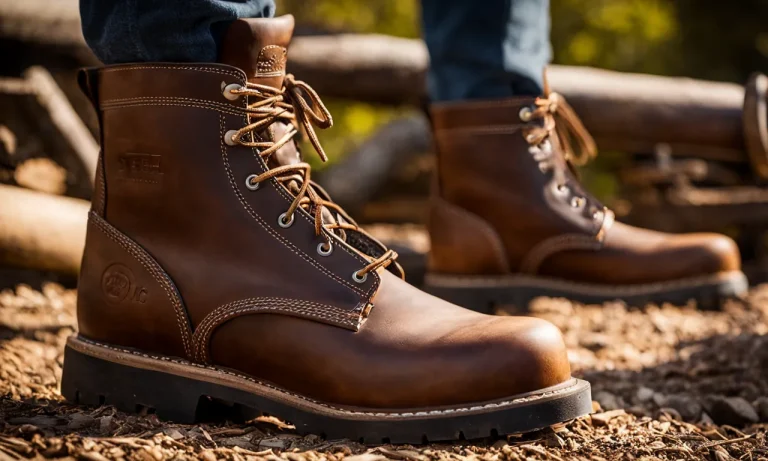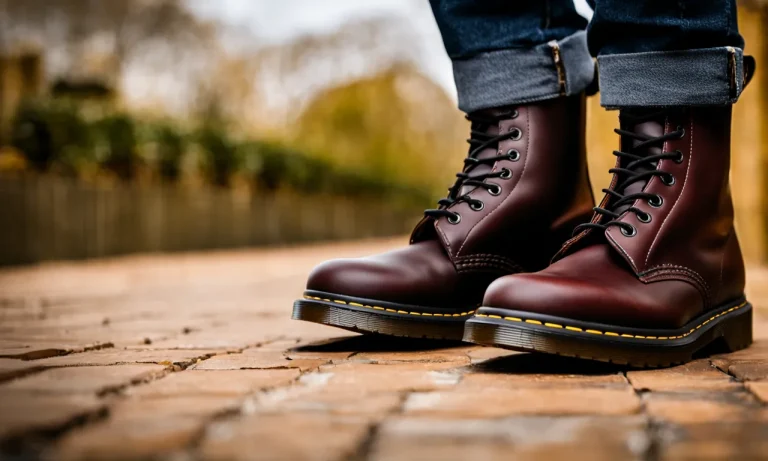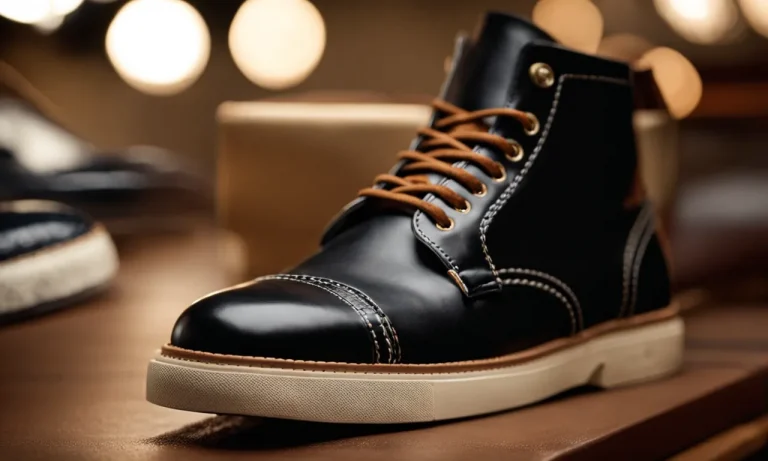With winter weather comes rain, slush, and puddles. Protecting your feet from getting wet is crucial during the colder months. But with so many waterproof boot options available, how do you choose between galoshes and rain boots?
If you’re short on time, here’s a quick answer to your question: Rain boots are better for heavy rains and deep puddles, while galoshes are a lightweight option more suited for light rain and slush. Read on for a detailed comparison of galoshes and rain boots to help you decide which is right for your needs.
In this comprehensive guide, we’ll compare galoshes and rain boots side-by-side. We’ll look at factors like protection, traction, warmth, style, and cost to help you determine the best waterproof boots for your lifestyle.
Whether you’re commuting to work or running errands around town, you’ll finish this article with everything you need to know to pick the perfect pair of wet weather boots.
Weather Protection
When it comes to protecting your feet from wet weather conditions, both galoshes and rain boots are excellent options. These waterproof boots are designed to keep your feet dry and comfortable, no matter how rainy or muddy it gets outside.
How Galoshes and Rain Boots Keep Feet Dry
Galoshes and rain boots utilize different materials and construction techniques to provide weather protection. Galoshes, also known as overshoes, are typically made of rubber or silicone and are designed to be worn over regular shoes.
They provide an extra layer of waterproof protection, ensuring that no water seeps through to your feet. On the other hand, rain boots are made entirely of rubber or synthetic materials, which makes them completely waterproof.
They are designed to be worn on their own, without the need for any additional footwear.
Puddle Depth and Rain Intensity
When deciding between galoshes and rain boots, it’s important to consider the depth of the puddles you will be encountering and the intensity of the rain. Galoshes are great for shallow puddles and light rain, as they offer sufficient protection to keep your feet dry.
However, if you often find yourself wading through deep puddles or braving heavy downpours, rain boots are the better choice. With their higher shafts and fully enclosed design, rain boots provide superior protection against water entering from the top.
Rubber Quality and Coverage
The quality of the rubber used in galoshes and rain boots can also affect their waterproof capabilities. High-quality rubber is more durable and less likely to develop cracks or leaks over time. Additionally, the coverage of the boots is an important factor to consider.
Galoshes typically cover only the lower part of the shoe, leaving the upper part exposed. Rain boots, on the other hand, provide full coverage up to the calf or knee, ensuring that no water can enter from any angle.
When choosing between galoshes and rain boots, it ultimately depends on your specific needs and the weather conditions you typically encounter. If you’re looking for a lightweight and versatile option for light rain, galoshes may be the way to go.
However, if you need maximum protection against heavy rain and deep puddles, rain boots are the better choice. Either way, investing in a pair of waterproof boots will keep your feet dry and comfortable, allowing you to enjoy rainy days without any worries.
Traction and Stability
When it comes to choosing between galoshes and rain boots, one important factor to consider is the traction and stability they offer. Having good traction is essential for walking on slippery surfaces, especially during rainy or snowy weather.
The stability of the boots ensures that you can maintain your balance and prevent accidents or falls.
Tread Patterns
The tread pattern of a boot plays a crucial role in providing traction. Galoshes typically have a simple, flat sole without much tread. While they may provide some grip, they may not be as effective on slippery surfaces.
On the other hand, rain boots often feature deep and intricate tread patterns that are designed to provide excellent traction on wet and slippery surfaces. These patterns help to disperse water and provide a firm grip on the ground, making them a better choice for walking on wet surfaces, such as wet grass or muddy paths.
Heel and Ankle Support
Another aspect that contributes to stability is the heel and ankle support of the boots. Galoshes usually have a flat sole without any specific support for the heel or ankle. While this may be suitable for light rain or occasional use, it may not provide the necessary stability for prolonged walks or activities.
Rain boots, on the other hand, often have a defined heel and ankle support, which helps to stabilize the foot and provide added support. This can be particularly beneficial when walking on uneven or slippery terrain.
Slip Resistance
Slip resistance is a crucial feature to consider when choosing waterproof boots. Rain boots are typically made from materials such as rubber or PVC, which naturally provide good slip resistance. They are designed to prevent slippage on wet surfaces, making them a safer option for walking in rainy conditions.
Galoshes, on the other hand, may not offer the same level of slip resistance, as they are often made from thinner materials that may not provide the same grip.
It is important to note that when it comes to traction and stability, the specific design and brand of the boots can also play a significant role. Some rain boots may have better traction and stability features compared to others, so it is always a good idea to do some research and read reviews before making a purchase.
Additionally, considering the intended use and the conditions you will be facing will help you determine which type of boot is right for you.
For more information on the different types of boots and their features, you can visit Outdoor Gear Lab, a reputable website that provides detailed reviews and comparisons of various outdoor gear, including rain boots.
Warmth
When it comes to choosing between galoshes and rain boots, warmth is an important factor to consider. After all, nobody wants to have cold and wet feet while braving the rain and snow. Both galoshes and rain boots offer some level of insulation, but there are a few key differences to keep in mind.
Insulation
Galoshes, also known as overshoes, are typically made of rubber or PVC material. While they provide a waterproof barrier, they don’t typically offer much insulation. In colder temperatures, you may need to wear thicker socks or add insoles to keep your feet warm.
Rain boots, on the other hand, often come with built-in insulation or lining that helps to keep your feet cozy even in chilly weather. Some rain boots even have fleece or faux fur lining for added warmth.
Fit
When it comes to warmth, the fit of the boots also plays a role. Galoshes are designed to be worn over existing shoes or boots, which means they may not fit as snugly as rain boots. This can create extra space inside the galoshes, making it harder for your body heat to warm your feet.
Rain boots, on the other hand, are designed to be worn on their own and often have adjustable straps or buckles to ensure a snug fit. This helps to trap heat inside the boots and keep your feet warmer.
Socks and Insoles
To enhance warmth in both galoshes and rain boots, you can wear appropriate socks and add insoles. Thermal or wool socks can provide extra insulation and moisture-wicking properties to keep your feet warm and dry.
Insoles, especially ones made from materials like sheepskin or wool, can also add an extra layer of warmth and comfort. It’s important to choose socks and insoles that fit well with your boots to maximize the benefits.
Style
When it comes to choosing between galoshes and rain boots, one important factor to consider is style. Both types of boots come in a variety of colors and designs, allowing you to express your personal style even on the rainiest days.
Color and Design Options
Rain boots often offer a wider range of color options compared to galoshes. You can find rain boots in vibrant shades like yellow, red, or even patterns like polka dots or floral prints. These bold designs can add a pop of color to your outfit and make rainy days a little more cheerful.
On the other hand, galoshes typically come in more traditional colors such as black or brown, which may be preferred for a more classic and understated look.
Fashion vs Function
When it comes to the clash between fashion and function, rain boots and galoshes have different strengths. Rain boots are often considered more fashionable, as they are designed to be worn as a regular shoe, allowing you to make a style statement while keeping your feet dry.
Galoshes, on the other hand, are primarily focused on functionality. They are typically worn over your regular shoes to provide an extra layer of protection against the rain, snow, or mud. While they may not be as fashionable as rain boots, they offer superior waterproofing capabilities.
Professional Settings
In professional settings, such as the workplace or formal events, rain boots are generally more acceptable than galoshes. Rain boots are available in sleek and sophisticated designs that can be paired with business attire or formal outfits.
On the other hand, galoshes are often perceived as more casual and may not be suitable for professional environments. If you frequently find yourself needing waterproof footwear in a professional setting, investing in a pair of stylish rain boots would be a wise choice.
Cost Comparison
Entry-Level Prices
When it comes to entry-level prices, galoshes and rain boots both offer affordable options for those on a budget. Galoshes, which are typically made of rubber, can be found for as low as $10 to $20 per pair.
These inexpensive boots are often designed to be worn over regular shoes, providing a quick and convenient solution for unexpected rain showers. On the other hand, rain boots, also made of rubber, usually start at around $20 to $30 per pair.
While they may be slightly pricier than galoshes, rain boots often offer more features and better overall protection against wet weather.
Premium Options
If you’re willing to invest a bit more in your waterproof boots, both galoshes and rain boots have premium options available. Galoshes that are made from high-quality materials, such as neoprene or PVC, can cost anywhere from $50 to $100.
These premium galoshes often provide additional insulation and comfort, making them ideal for colder climates or extended wear. Similarly, rain boots with advanced features, such as adjustable straps, cushioned insoles, and reinforced soles, can range from $50 to $150 per pair.
These premium rain boots offer enhanced durability and comfort, making them suitable for more demanding activities like hiking or working outdoors.
Durability and Lifespan
When considering the durability and lifespan of galoshes versus rain boots, it’s important to note that both options can vary significantly depending on the brand, materials, and construction. Generally, rain boots tend to be more durable and longer-lasting compared to galoshes.
With proper care, a high-quality pair of rain boots can last for several years, even with regular use. Galoshes, while still capable of providing adequate waterproofing, may not offer the same level of durability.
However, it’s worth mentioning that galoshes are often designed as a temporary solution for rainy days, rather than long-term footwear.
In terms of maintenance, both galoshes and rain boots require some upkeep to ensure their longevity. Regular cleaning and drying are recommended for both types of boots to prevent the growth of mold and keep the material in good condition.
Additionally, storing the boots in a cool, dry place when not in use can help extend their lifespan.
Conclusion
When selecting rain boots or galoshes, consider your climate, planned uses, and individual needs. Galoshes offer affordable, portable wet weather foot protection, while classic rain boots keep feet drier but are clunkier.
Evaluate factors like weather conditions, underfoot traction, warmth, style, and budget to decide which type of waterproof boot works best for your lifestyle.
Stay dry and comfortable this winter by choosing the perfect pair of waterproof boots for your needs. With the right galoshes or rain boots, you’ll be prepared to take on whatever this season brings!






